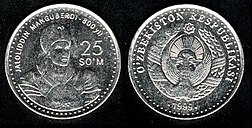Uzbekistan som
| Uzbekistani so'm | |
|---|---|
| Oʻzbekiston soʻmi / Ўзбекистон сўми (Uzbek) | |

25 so'm.
|
|
| ISO 4217 | |
| Code | UZS |
| Denominations | |
| Subunit | |
| 1/100 | Tiyin |
| Plural | so'm |
| Tiyin | Tiyin |
| Banknotes | 1, 3, 5, 10, 25, 50, 100, 200, 500, 1000, 5000 so'm |
| Coins | 1, 5, 10, 25, 50, 100, 500 so'm |
| Demographics | |
| User(s) |
|
| Issuance | |
| Central bank | Central Bank of the Republic of Uzbekistan |
| Website | www.cbu.uz |
| Valuation | |
| Inflation | 8.5% |
| Source | [1], 2015 est. |
The so'm (Uzbek: soʻm in Latin script, сўм in Cyrillic script) is the currency of Uzbekistan in Central Asia. The ISO 4217 currency code is UZS.
In the Soviet Union, speakers of Kazakh, Kyrgyz and Uzbek called the ruble the som, and this name appeared written on the back of banknotes, among the texts for the value of the bill in all 15 official languages of the Union. The word som (sometimes transliterated "sum" or "soum") means "pure" in Kyrgyz, Uyghur and Uzbek, as well as in many other Turkic languages. The word implies "pure gold".
Like other republics of the former Soviet Union, Uzbekistan continued using the Soviet/Russian ruble after independence. On July 26, 1993, a new series of Russian ruble was issued and the old Soviet/Russian ruble ceased to be legal tender in Russia. Some successor states had their national currencies before the change, some chose to continue using the pre-1993 Soviet/Russian ruble, and some chose to use both the pre-1993 and the new Russian ruble. Tables of modern monetary history: Asia implies that both old and new rubles were used in Uzbekistan.
Uzbekistan replaced the ruble with so'm at par in on November 15, 1993. No subdivisions of this som were issued and only banknotes were produced, in denominations of 1, 3, 5, 10, 25, 50, 100, 200, 500, 1000, 5000, and 10,000 so'm. Because it was meant to be a transitional currency, the design was rather simplistic. All notes had the Coat of arms on obverse, and Sher-Dor Madrasah of the Registan in Samarkand on reverse.
...
Wikipedia
